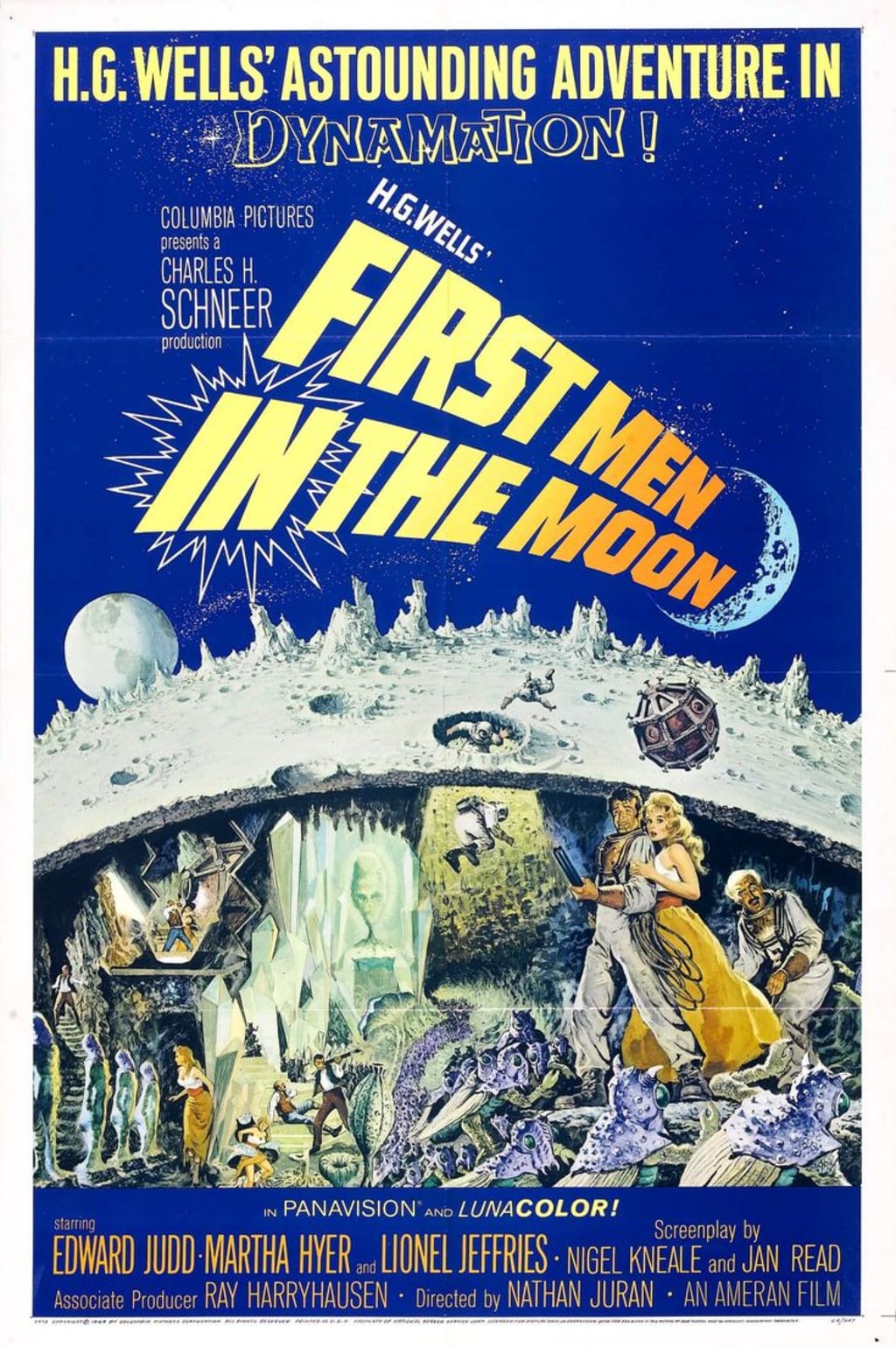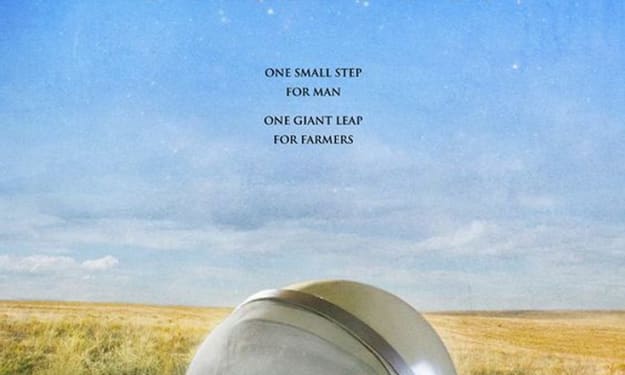Genuine Review of the 1964 Sci-fi/Adventure Film 'First Men in the Moon'
First Men in the Moon (1964): A Honest Film Review

"First Men in the Moon," directed by Nathan Juran and released in 1964, is a classic sci-fi adventure film based on H.G. Wells' 1901 novel of the same name. The movie combines elements of Victorian-era science fiction with imaginative special effects, courtesy of the legendary Ray Harryhausen. Starring Edward Judd, Martha Hyer, and Lionel Jeffries, the film takes audiences on a whimsical and thrilling journey to the Moon, capturing the wonder and curiosity of early space exploration tales.
Plot Summary:
The story begins in the 1960s with a United Nations moon mission discovering a Union Jack flag and a document claiming the Moon for Queen Victoria. This surprising find leads to an investigation that uncovers the story of an earlier, secretive expedition to the Moon.
The narrative then shifts to the late 19th century, where we meet Bedford (Edward Judd), a struggling playwright, and Professor Cavor (Lionel Jeffries), an eccentric scientist who has invented "Cavorite," a substance that can negate gravity. Cavor's invention paves the way for an ambitious journey to the Moon. Bedford, seeing an opportunity for fame and fortune, joins Cavor on this groundbreaking expedition.
Accompanied by Bedford's fiancée, Kate Callender (Martha Hyer), the two men embark on their journey in a spherical spacecraft coated with Cavorite. Upon landing on the Moon, they discover an underground civilization of insect-like creatures known as Selenites. The explorers face numerous challenges and adventures as they navigate this alien environment, encountering strange flora and fauna and the enigmatic Selenites.
Visual and Technical Aspects:
"First Men in the Moon" is a visual treat, thanks to Ray Harryhausen's innovative special effects. The film's stop-motion animation brings the Selenites and the lunar landscape to life, creating a sense of wonder and otherworldliness. The lunar surface is depicted with a blend of imagination and scientific curiosity, reflecting the film's Victorian roots.
The spacecraft design, with its Victorian aesthetic, adds to the film's charm. The attention to detail in the set design and costumes enhances the period feel, transporting viewers back to a time when the concept of space travel was both fantastical and awe-inspiring. The cinematography by Wilkie Cooper effectively captures the contrast between the Earthly Victorian setting and the alien environment of the Moon.
Suspense and Tension:
The film balances suspense and adventure with moments of humor and whimsy. The initial journey to the Moon is filled with tension as Bedford and Cavor contend with the unknown dangers of space travel. The discovery of the Selenites introduces a new layer of suspense, as the explorers must navigate their interactions with the alien creatures and uncover their intentions.
The tension is heightened by the characters' frequent brushes with danger, whether it's evading the Selenites or dealing with the challenges of the lunar environment. These moments are interspersed with lighter scenes that highlight the eccentricities of the characters, particularly Cavor's absent-minded yet brilliant persona.
Character Development and Performances:
The performances in "First Men in the Moon" are delightful, with Lionel Jeffries stealing the show as the eccentric Professor Cavor. His portrayal of the absent-minded inventor is both humorous and endearing, capturing the spirit of Victorian scientific curiosity. Jeffries' comedic timing and expressive mannerisms bring Cavor to life, making him a memorable and lovable character.
Edward Judd as Bedford provides a grounded counterpoint to Cavor's eccentricity. His character's pragmatism and ambition drive much of the plot, and Judd effectively conveys Bedford's transformation from a skeptical businessman to an adventurous explorer. Martha Hyer's role as Kate adds a touch of romance and humanity to the story, though her character is somewhat underdeveloped compared to the male leads.
Themes and Reflections:
"First Men in the Moon" explores themes of exploration, scientific discovery, and the clash of cultures. The film reflects the Victorian era's fascination with science and progress, embodying the spirit of adventure that characterized the period. The journey to the Moon symbolizes humanity's unending quest for knowledge and the desire to push the boundaries of what is possible.
The interaction with the Selenites introduces themes of cultural exchange and the fear of the unknown. The film subtly critiques colonial attitudes by depicting the explorers' initial misunderstanding and subsequent respect for the alien civilization. This narrative encourages viewers to approach the unknown with curiosity and respect rather than fear and domination.
Critique and Unique Elements:
While "First Men in the Moon" is an engaging and imaginative film, it does have some shortcomings. The pacing can be uneven at times, with certain scenes feeling slow compared to the more action-packed sequences. Additionally, the film's portrayal of Kate as a secondary character reflects the gender norms of the 1960s, which might feel outdated to modern audiences.
However, these issues are minor compared to the film's overall charm and creativity. The unique blend of Victorian aesthetics with sci-fi adventure sets "First Men in the Moon" apart from other films of its time. Harryhausen's special effects remain a highlight, showcasing the artistry and innovation that defined his career.
Conclusion:
"First Men in the Moon" is a delightful and imaginative sci-fi adventure that captures the spirit of early space exploration tales. With its charming performances, inventive special effects, and engaging storyline, the film offers a nostalgic look at a bygone era of science fiction. Lionel Jeffries' standout performance as Professor Cavor and Ray Harryhausen's masterful effects make this film a must-watch for fans of classic sci-fi cinema.
Whether you're a fan of H.G. Wells' original novel or simply enjoy a good adventure, "First Men in the Moon" provides an entertaining and thought-provoking journey to the stars. Its blend of humor, suspense, and wonder makes it a timeless classic that continues to captivate audiences over half a century after its release.
About the Creator
Aarav Rohilla
Hey Everyone,
This is Aarav Rohilla, a young writer on a mission to craft captivating stories that resonate.
Join me on this journey of literary exploration and inspiration! 📝✨
Enjoyed the story? Support the Creator.
Subscribe for free to receive all their stories in your feed. You could also pledge your support or give them a one-off tip, letting them know you appreciate their work.
Reader insights
Outstanding
Excellent work. Looking forward to reading more!
Top insights
Compelling and original writing
Creative use of language & vocab
Easy to read and follow
Well-structured & engaging content
Excellent storytelling
Original narrative & well developed characters
Expert insights and opinions
Arguments were carefully researched and presented
Eye opening
Niche topic & fresh perspectives
Heartfelt and relatable
The story invoked strong personal emotions
Masterful proofreading
Zero grammar & spelling mistakes
On-point and relevant
Writing reflected the title & theme






Comments (2)
Your review was a perfect blend of analysis and passion. Great job!
You’ve articulated the film’s strengths and weaknesses brilliantly. Nice work!